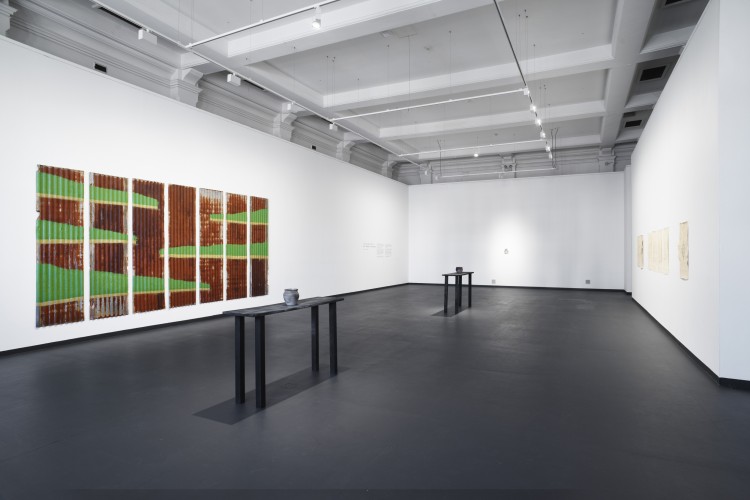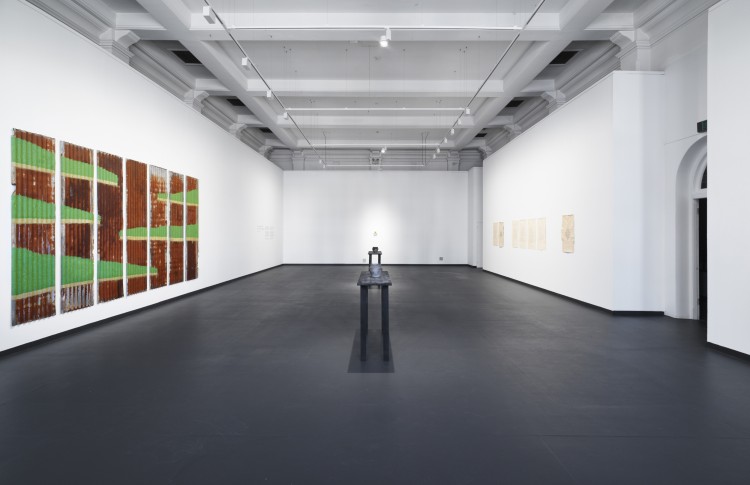Women Celebrating, Sydenham Road, Durban 1954, reproduction of black and white photograph.
kotri/barkis 2023, acrylic and enamel paint, corrugated iron. Studio assistance: Miri Badger, Kate Halling, and Jack Hardy.
From my mother’s 2023, paper made using mango bark from mother’s garden, pigment made from sugarcane ash. Paper made with Kate Halling.
mā maram 2023, scorched reclaimed mango wood, kondil / kulli (sheoak), hand-burnished black clay lotas fired in sugarcane and sawdust, scent distilled from mango leaves and smoke from burning sugarcane, sound. Ceramics made with Miri Badger. Tables made with David Brazier and Ben Leadbetter.
Curated by Sarah Wall, Perth Institute of Contemporary Art (PICA), August 2023.
In ām / ammā / mā maram, Meanjin (Brisbane)-based artist Sancintya Mohini Simpson continues her research into her matrilineal heritage, making visible the histories of indentured Indian women that remain marginal or erased in colonial archives.
Simpson is a first-generation Australian and descendent of labourers sent from the port of Madras (now Chennai), India to work on sugar plantations in the British colony of Natal, South Africa (now KwaZulu-Natal) between 1863 and 1911. In ām / ammā / mā maram, Simpson traces her family’s journey through materials common to these places and histories – such as sugarcane and mango.
The exhibition’s title is inspired by a black-and white photograph featuring multiple generations of women, including members of the artist’s family, sitting under a mango tree. It borrows from three different languages spoken in India: ām (mango in Hindi), ammā (a term for mother throughout India), and mā maram (mango tree in Tamil).
Through a combination of paintings, sculpture, poetry and scent, ām / ammā / mā maram offers a speculative archive that represents the lives and experiences of female plantation workers missing from the written record. In imagining and giving form to their stories, ām / ammā / mā maram underscores the enduring legacy of indenture and dislocation, and the necessity of looking back as a step towards healing and reconciliation.
Women Celebrating, Sydenham Road, Durban 1954, reproduction of black and white photograph.
This photograph is one of the few images in the artist’s possession of her maternal great-grandmother and great-great-grandmother. Taken in Durban, Natal (now KwaZulu-Natal, South Africa), they are pictured amongst a group of women gathered under a mango tree. In the background is a tin house typical of the informal settlements constructed in Durban as Indian labourers who had completed their indenture on sugar plantations moved to the city. While some returned to India, many, including Simpson’s ancestors, chose to stay in South Africa where they suffered further displacement due to devastating river floods and the implementation of apartheid. Today these landmarks stand as important remnants of their history.
Women Celebrating, Sydenham Road, Durban offers a glimpse into the world of migrant South Asian women, depicting a social space of community, solidarity and survival. Placed at the exhibition’s entrance, it is an invitation to remember and reimagine their intimate experiences.
kotri/barkis 2023, acrylic and enamel paint, corrugated iron.
Drawing inspiration from the murals that decorate the walls of temples and palaces in India, Simpson’s seven-panel painting presents a panoramic view of a sugarcane plantation. Executed in the style of traditional Indian miniature painting, the landscape is notably devoid of people. Human presence is suggested only through the use of weathered corrugated iron sheets, a nod to the makeshift barracks that housed plantation labourers. The use of enamel paint in Simpson’s work references the Indian enamelware commonly used for cooking and tableware, signifying the daily activities of women within this diasporic community.
Against this rusted iron backdrop, the light, bright greens of the striped sugarcanes and their grassy shoots stand out in high relief. Leaving significant areas untouched, Simpson directs our attention to what we cannot see – to the invisible and forgotten histories in the landscape.
From my mother’s 2023, paper made using mango bark from mother’s garden, pigment made from sugarcane ash.
Writing is central to Simpson’s practice as a means of processing and articulating intergenerational trauma. In her poetry and spoken word performances, she explores tales of migration, ships and sugar that have been handed down to her through generations. Written in memory of her matrilineal ancestors in Natal, Simpson’s words conjure up images, sounds, smells and other sensations that she draws from her ancestors’ often turbulent and traumatic experiences.
Pinned to the wall, Simpson’s poems and fine linework are composed in a black pigment made from sugarcane mulch that she burns to ash and then grinds into powder. Her own delicate, hand-pulped paper incorporates leaves and bark fibres from the mango tree growing in her mother’s garden. Both in her use of materials and in the poems’ narratives – moving across oceans and between the past and present – Simpson interweaves personal histories with those of the women who came before her.
mā maram 2023, scorched reclaimed mango wood, kondil / kulli (sheoak), hand-burnished black clay lotas fired in sugarcane and sawdust, scent distilled from mango leaves and smoke from burning sugarcane.
mā maram comprises a pair of small clay lotas (vessels) sitting atop two tables fabricated from mango wood. The lengths of the individual tabletops have been made to the same height of the artist and her mother respectively. The arrangement of the tables and vessels echo each other, following a line of sight with the family photograph and establishing a direct connection across the generations of women memorialised in Simpson’s exhibition.
Fabricated from reclaimed wood and treated with fire, the tables’ charcoal black finish serves as an analogy for kala pani (black waters) of the Indian Ocean that Simpson’s ancestors crossed to reach the British colony of Natal. The clay lotas, fired in sugarcane and sawdust, stand as repositories and transmitters of these histories.
From inside the bodies of the vessels a soft fragrance emanates, blending the smokiness of sugarcane ash with the green notes of mango tree. In this work, memories are recalled not through text or images but through sensations embodied in the materiality of places and objects.
Text by Sarah Wall.


































